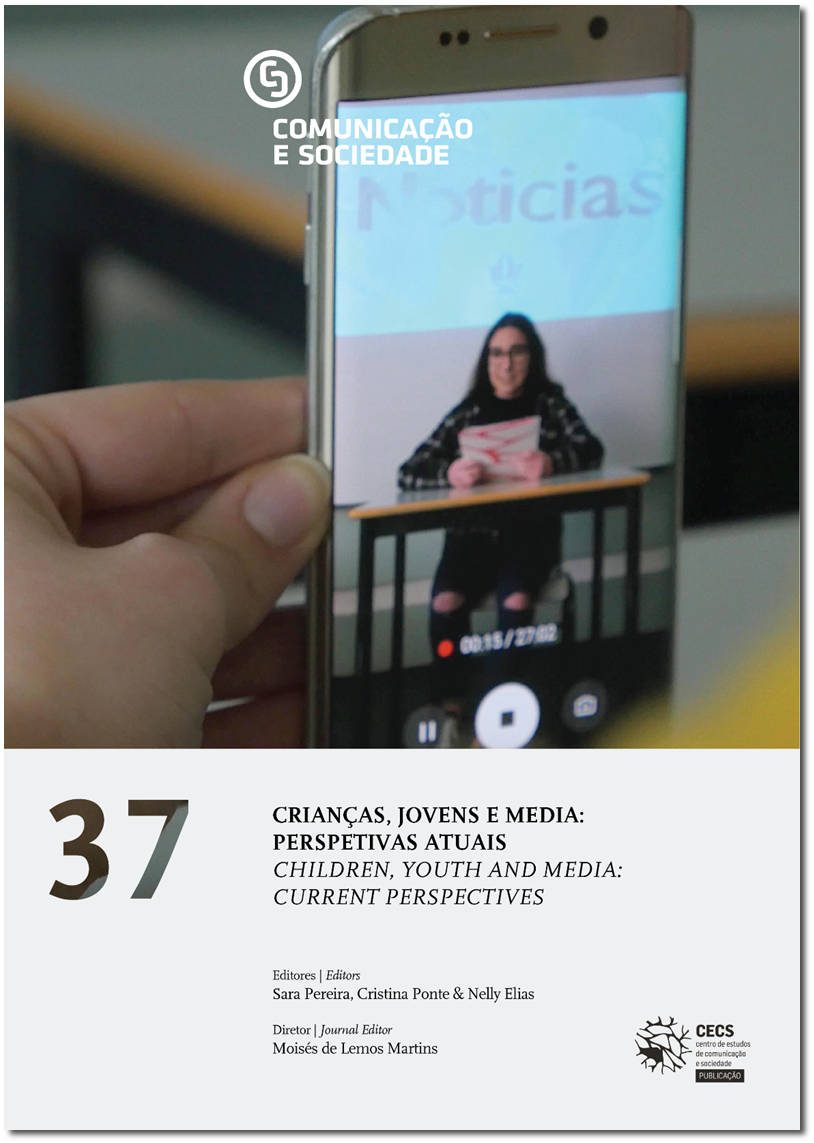“I’m sorry you don’t flag it when you advertise”: audience and commercial content on the Sofia Barbosa YouTube channel
DOI:
https://doi.org/10.17231/comsoc.37(2020).2394Keywords:
young people, microcelebrity, authenticity, commercialism, YouTubeAbstract
The main theme of the article is the context of digital microcelebrity experienced by children and adolescents, particularly on social networking sites such as YouTube. The purpose of the study is to understand how young audiences of the popular Portuguese channel Sofia Barbosa on YouTube construct meaning about the commercial content and authenticity that the youtuber presents. The methodology used is qualitative bias and netnography is employed in analysing 1.961 comments made by subscribers on 10 videos posted between January and October 2018. As a means of better understanding the context of the comments we also analysed the visual, verbal and commercial aspects of the videos. The comments demonstrate a perception on the part of followers of closeness and intimacy in relation to Sofia and a strong acceptance of the commercial content promoted by the young woman. However, critical reflections about the marketing practices of the youtuber can at various times be perceived, namely on the lack of transparency in commercial relations; this presents itself as an opportunity to balance a romanticised view that many subscribers have of microcelebrities with a more rational understanding of the industry that sustains them.Downloads
References
Anderson, M. & Jiang, J. (2018). Teens, social media & technology 2018. Washington: Pew Research Center. Retirado de https://www.pewresearch.org/internet/2018/05/31/teens-social-media-technology-2018/
Banet-Weiser, S. (2011). Branding the post-feminist self: girls’ video production and YouTube. In M. C. Kearney (Ed.), Mediated girlhoods: new explorations of girls’ media culture (pp. 277-294). Nova Iorque: Peter Lang.
Burgess, J. & Green, J. (2009). YouTube e a revolução digital: como o maior fenômeno da cultura participativa transformou a mídia e a sociedade. São Paulo: Aleph.
Castells, M. (2007). A galáxia internet. Reflexões sobre internet negócios e sociedade. Lisboa: Fundação Calouste Gulbenkian.
Carvalho, B. J. (2019). Entre o afeto e o consumo: perceções e interações de uma jovem youtuber e suas audiências. Dissertação de Mestrado, Universidade do Minho, Braga, Portugal. Retirado de http://repositorium.sdum.uminho.pt/handle/1822/61234
Chaves, S. (2017, 19 de novembro). 8 vloggers de beleza que deve seguir no Instagram. Nit. Retirado de https://nit.pt/vanity/beleza/vloggers-beleza-seguir-instagram
Crawford, M. (2015). Introduction: attention as a cultural problem. In C. Matthew (Ed.), The world beyond your head: on becoming an individual in an age of distraction (pp. 3-28). Nova Iorque: Farrar, Straus and Giroux.
Fragoso, S., Recuero, R. & Amaral, A. (2011). Métodos de pesquisa para internet. Porto Alegre: Sulina.
García-Rapp, F. (2017). Popularity markers on YouTube’s attention economy: the case of Bubzbeauty. Celebrity Studies, 8(2), 228–245. https://doi.org/10.1080/19392397.2016.1242430.
Igartua, J. & Humanes, M. (2004). El método científico aplicado a la investigación en comunicación social. Aula abierta, Lecciones básicas. Portal de la Comunicación. Retirado de https://www.researchgate.net/profile/Maria_Humanes/publication/237584442_El_metodo_cientifico_aplicado_a_la_investigacion_en_comunicacion_social/links/00b49526104d2d1485000000/El-metodo-cientifico-aplicado-a-la-investigacion-en-comunicacion-social.pdf
Jorge, A., Amaral, I. & Mathieu, D. (2018). The co-option of audiences in the attention economy: introduction. Observatório [Vol. Especial], 1-4.
Jorge, A., Marôpo, L. & Nunes, T. (2018). ‘I am not being sponsored to say this’: a teen youtuber and her audience negotiate branded content. Observatório [Vol. Especial], 76-96.
Khamis, S., Ang, L. & Welling, R. (2016). Self- branding, ‘micro-celebrity’ and the rise of Social Media Influencers. Celebrity Studies, 18, 1-18. http://dx.doi.org/10.1080/19392397.2016.1218292
Lipovetsky, G. & Serroy, J. (2010). O ecrã global: cultura mediática e cinema na era hipermoderna. Lisboa: Edições 70.
Marôpo, L., Sampaio, I. & Pereira, N. (2018). Meninas no YouTube: participação, celebrização e cultura do consumo. Estudos em Comunicação, 16(1), 175-195.
Marwick, A. E. (2010). Status update: celebrity, publicity and self-branding in web 2.0. Tese de Doutoramento, New York University, Nova Iorque, EUA. Retirado de https://www.academia.edu/27795511/Status_Update_Celebrity_Publicity_and_Self_Branding_in_Web_2.0_PhD_Dissertation
NRF & IBM. (2017). Uniquely gen Z: executive report. Retirado de https://nrf.com/research/uniquely-gen-z
O’Neil-Hart, C. & Blumenstein, H. (2016, junho). Why YouTube stars are more influential than traditional celebrities [Post em blogue]. Retirado de https://goo.gl/7YdeSD
Pereira, S., Moura, P. & Fillol, J. (2018). The youtubers phenomenon: what makes YouTube stars so popular for young people? Fonseca, Journal of Communication, 17, 107-123.
Pereira, S., Pinto, M. & Moura, P. (2015). Níveis de literacia mediática: estudo exploratório com jovens do 12º ano. Braga: CECS.
Raun, T. (2018). Capitalizing intimacy: New subcultural forms of micro- celebrity strategies and affective labour on YouTube. Convergence: The International Journal of Research into New Media Technologies, 24(1), 99–113. https://doi.org/10.1177/1354856517736983.
Sampaio, I & Cavalcante, A. (2016). Publicidade infantil em tempos de convergência. Relatório final, Universidade Federal do Ceará, Ceará, Brasil.
Senft, T. (2008). Camgirls: celebrity and community in the age of social networks. Estados Unidos: Peterlang.
TEDx Talks. (2018). “Nunca Digas Nunca” | Sofia Barbosa | TEDxBraga. Retirado de https://www.youtube.com/watch?v=gtxNZwcwD9s
Tomaz, R. (2017). O que você vai ser antes de crescer: youtubers, infância e celebridade. Tese de Doutoramento, Universidade Federal do Rio de Janeiro, Rio de Janeiro, Brasil.
Van Dijck, J. (2017). Confiamos nos dados? As implicações da datificação para o monitoramento social. Matrizes, 11(1), 39-59. https://doi.org/10.11606/issn.1982-8160.v11i1p39-59
Williamson, D. (2016, 4 de março). Como as marcas podem usar influenciadores. Meio e Mensagem. Retirado de http://www.meioemensagem.com.br/home/marketing/2016/03/04/como-as-marcas-podem-usar-influenciadores.html
Downloads
Published
How to Cite
Issue
Section
License
Authors own the copyright, providing the journal with the right of first publication. The work is licensed under a Creative Commons Attribution 4.0 International License.












